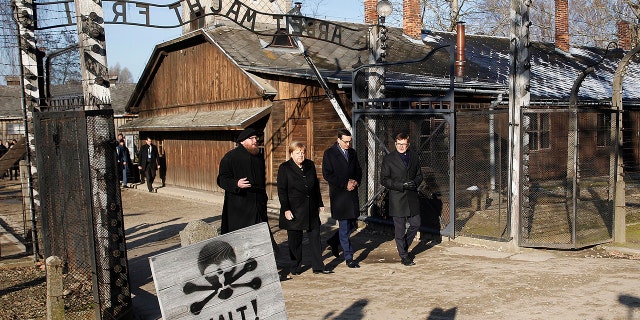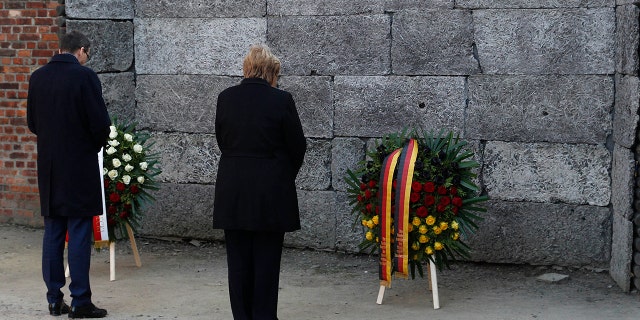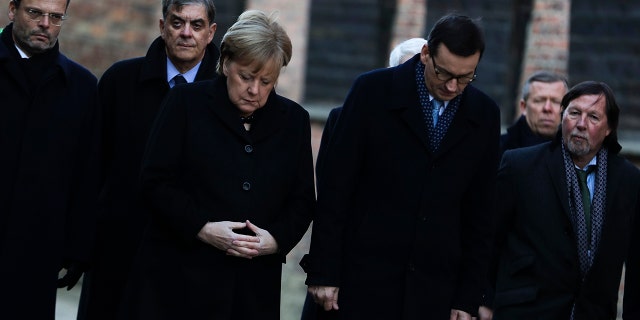German Chancellor Angela Merkel visited the former Nazi death camp Auschwitz-Birkenau on Friday, marking her first-ever visit to the notorious site in her 14 years as Germany’s leader.
Merkel, accompanied by Polish Prime Minister Mateusz Morawiecki, began her visit by seeing a crematorium and then walked under the infamous gate with the words “Arbeit Macht Frei” – “Work will set you free” – before seeing the camp’s brick barracks.
The two leaders also went to the so-called Black Wall, where thousands of prisoners were executed. There they bowed their heads before two wreaths bearing their nations’ colors.
GERMAN ACTIVISTS APOLOGIZE FOR USE OF HOLOCAUST VICTIMS’ REMAINS IN ANTI-NAZI INSTALLATION

Museum director Piotr Cywinski, German Chancellor Angela Merkel, Polish Prime Minister Mateusz Morawiecki and deputy director Andrzej Kacorzyk, from left, visit the former Nazi death camp of Auschwitz-Birkenau in Oswiecim, Poland on Friday, Friday, Dec. 6, 2019. (AP Photo/Czarek Sokolowski)
Merkel is set to give a speech at the Birkenau extermination camp, where the gas chambers and crematoriums were built. She was invited to the death camp for the 10th anniversary of the Auschwitz-Birkenau Foundation.
During her tenure as chancellor, Merkel has not shied away from admitting German responsibility for the atrocities at the hands of Adolf Hilter and the Nazis during World War II.
Merkel has paid her respects at other Nazi concentration camps, and she has been five times to Israel’s Holocaust museum and memorial Yad Vashem.
Her visit to Auschwitz will ensure she follows in the footsteps of two former chancellors by seeing the site before her term ends.
HOLOCAUST SURVIVORS REUNITE WITH GREEK RESCUER IN FADING RITUAL

German Chancellor Angela Merkel, left, and Polish Prime Minister Mateusz Morawiecki, right, place flowers at the Death Wall during their visit of the former Nazi death camp of Auschwitz-Birkenau in Oswiecim, Poland.
(AP)
Merkel brought a donation of 60 million euros ($66.6 million) that will go to a fund to conserve the physical remnants of the site — the barracks, watchtowers, and personal items like shoes and suitcases of those killed.
Those objects endure as evidence of German atrocities and as one of the world’s most recognizable symbols of humanity’s capacity for evil. But they also are deteriorating under the strain of time and mass tourism, prompting a long-term conservation effort.
That donation to the Auschwitz Foundation comes in addition to 60 million euros that Germany donated when the fund was created a decade ago, according to the Auschwitz-Birkenau state museum. It also makes Germany by far the most generous of 38 countries that have contributed to the fund.
DAVID MARIASCHIN: STOP TRIVIALIZING THE HOLOCAUST
“Auschwitz is a museum but is also the biggest cemetery in the world… (Memory) is the key to building the present and future,” museum director Piotr Cywinski told Reuters ahead of Merkel’s visit at the invitation of the Auschwitz Foundation.

German Chancellor Angela Merkel, center left, and Polish Prime Minister Mateusz Morawiecki, center right, attend a wreath-laying ceremony at the death wall in the former Nazi death camp of Auschwitz-Birkenau in Oswiecim, Germany, Friday, Dec. 6, 2019. Merkel visits the former death camp in the occasion of the 10th anniversary of the founding of the Auschwitz Foundation.
(Photo/Markus Schreiber)
Poland’s Foreign Ministry called her visit “historic,” in an acknowledgment of the unique status Auschwitz has in the world’s collective memory.
Merkel’s visit comes as Europe has seen a spike in anti-Semitic sentiment. A new report by the New York-based Anti-Defamation League (ADL) found that one in four Europeans hold anti-Semitic beliefs.
“These findings serve as a powerful wake-up call that much work remains to be done to educate broad swaths of the populations in many of these countries to reject bigotry, in addition to addressing the pressing security needs where violent incidents are rising,” ADL CEO Jonathan Greenblatt said.
CLICK HERE TO GET THE FOX NEWS APP
Nazi German forces killed an estimated 1.1 million people at the Auschwitz-Birkenau complex during their occupation of Poland during World War II. Most of the victims were Jews transported from across Europe to be killed in gas chambers. But tens of thousands of others were killed there too, including Poles, Soviet prisoners of war and Roma, or Gypsies. The camp was liberated by the Soviet army on Jan. 27, 1945.
Fox News’ Talia Kaplan and the Associated Press contributed to this report.
